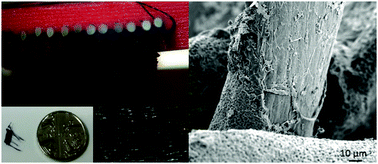Pristine carbon nanotube scaffolds for the growth of chondrocytes
Abstract
The effective growth of chondrocytes and the formation of cartilage is demonstrated on scaffolds of aligned carbon nanotubes; as two dimensional sheets and on three dimensional textiles. Raman spectroscopy is used to confirm the presence of chondroitin sulfate, which is critical in light of the unreliability of traditional dye based assays for carbon nanomaterial substrates. The textile exhibits a very high affinity for chondrocyte growth and could present a route to implantable, flexible cartilage scaffolds with tuneable mechanical properties.

- This article is part of the themed collection: 2017 Journal of Materials Chemistry B HOT Papers


 Please wait while we load your content...
Please wait while we load your content...